Abstract
Murine thioglycollate-elicited peritoneal macrophages were cultured in the presence of a variety of fatty acids added as complexes with bovine serum albumin. All fatty acids tested were taken up readily by the cells and both neutral and phospholipid fractions were enriched with the fatty acid provided in the medium. This generated a range of cells enriched in saturated, monounsaturated or polyunsaturated fatty acids, including n-3 acids of fish oil origin. Saturated fatty acid enrichment enhanced macrophage adhesion to both tissue culture plastic and bacterial plastic compared with enrichment with polyunsaturated fatty acids. Macrophages enriched with the saturated fatty acids myristate or palmitate showed decreases of 28% and 21% respectively in their ability to phagocytose unopsonized zymosan particles. Those enriched with polyunsaturated fatty acids showed 25-55% enhancement of phagocytic capacity. The greatest rate of uptake was with arachidonate-enriched cells. Phagocytic rate was highly correlated with the saturated/unsaturated fatty acid ratio, percentage of polyunsaturated fatty acid and index of unsaturation, except for macrophages enriched with fish-oil-derived fatty acids; they showed lower phagocytic activity than expected on the basis of their degree of unsaturation. These results suggest that membrane fluidity is important in determining macrophage adhesion and phagocytic activity. However, in the case of phagocytosis, this effect may be partially overcome if the cells are enriched with fish-oil-derived fatty acids. Thus it may be possible to modulate the activity of cells of the immune system, and so an immune response, by dietary lipid manipulation.
Full text
PDF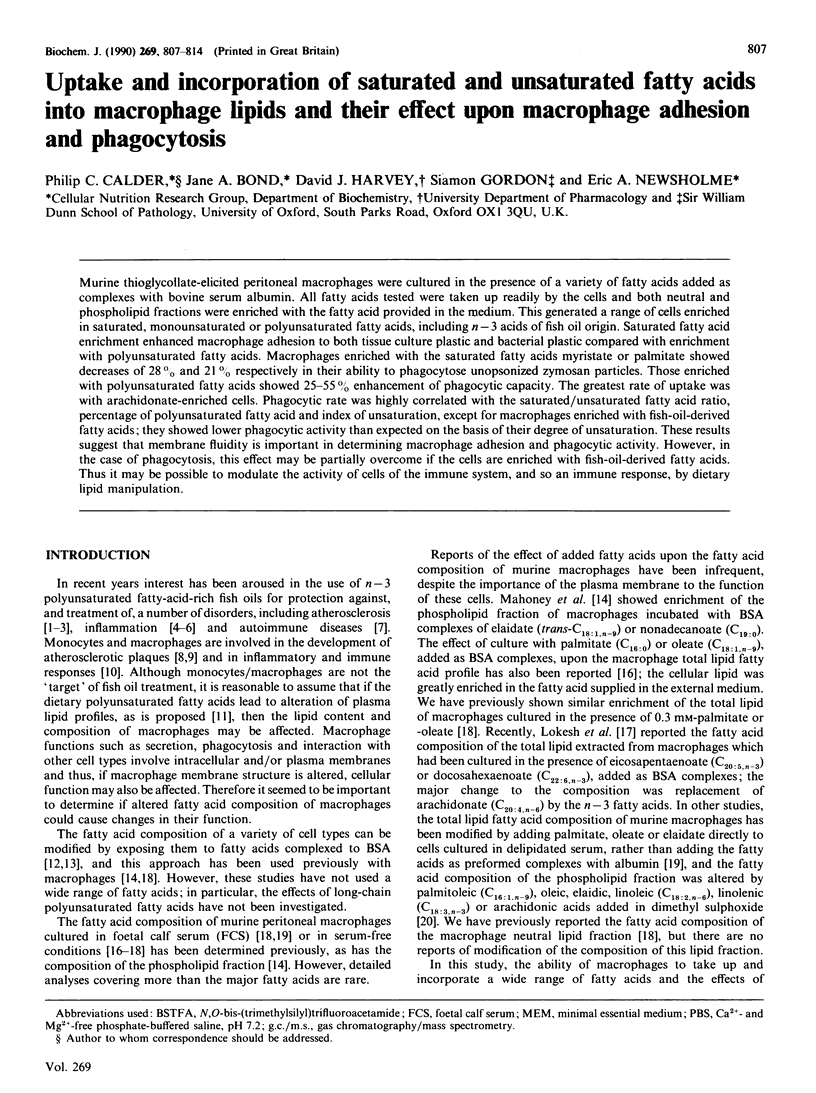
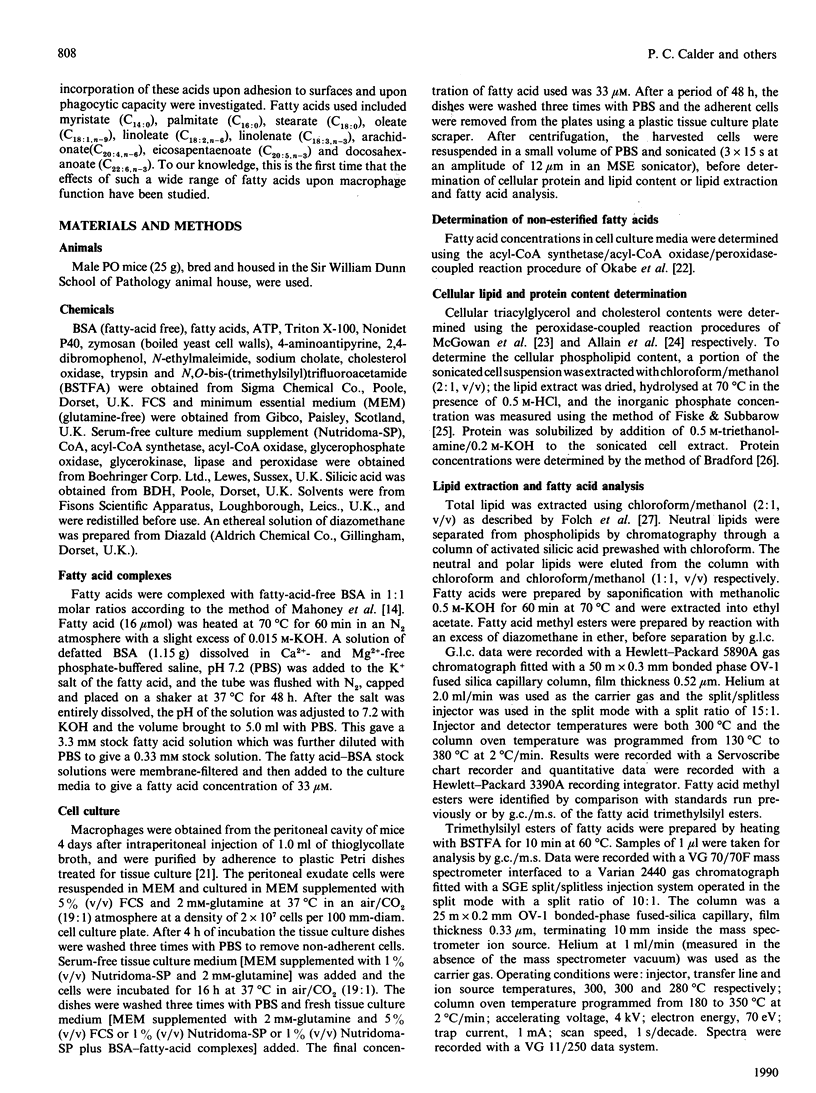
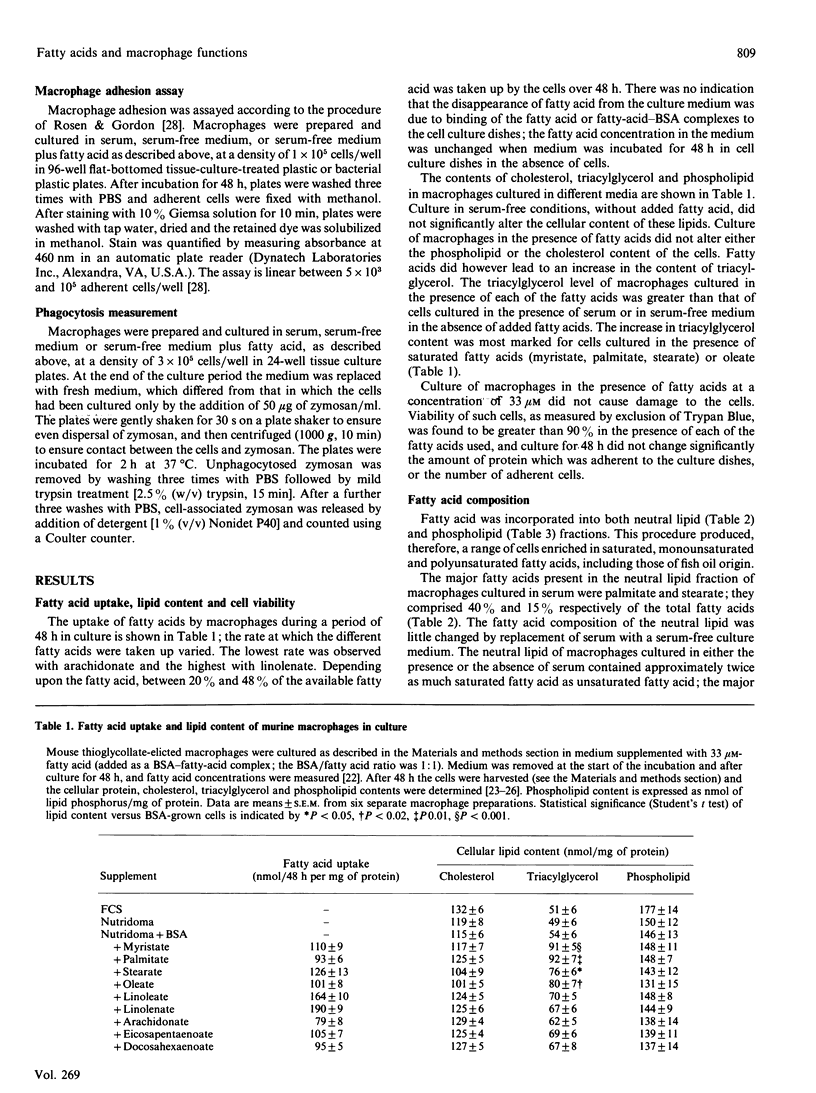
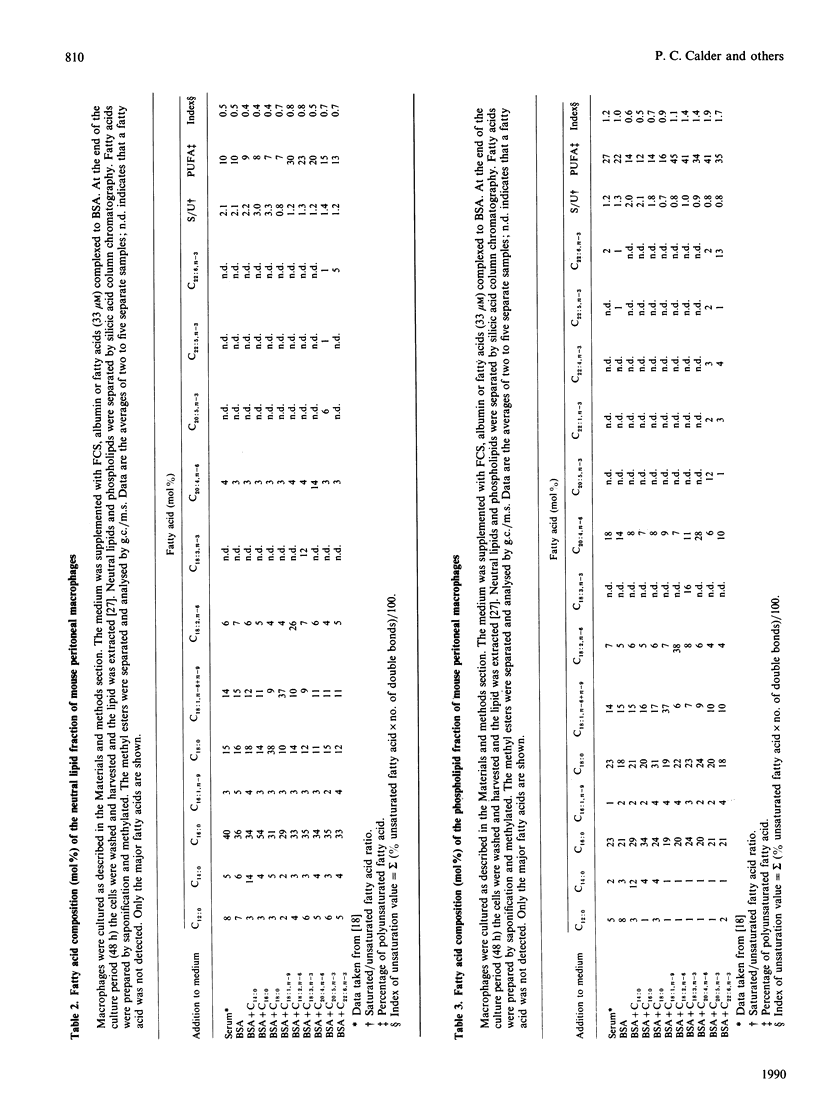
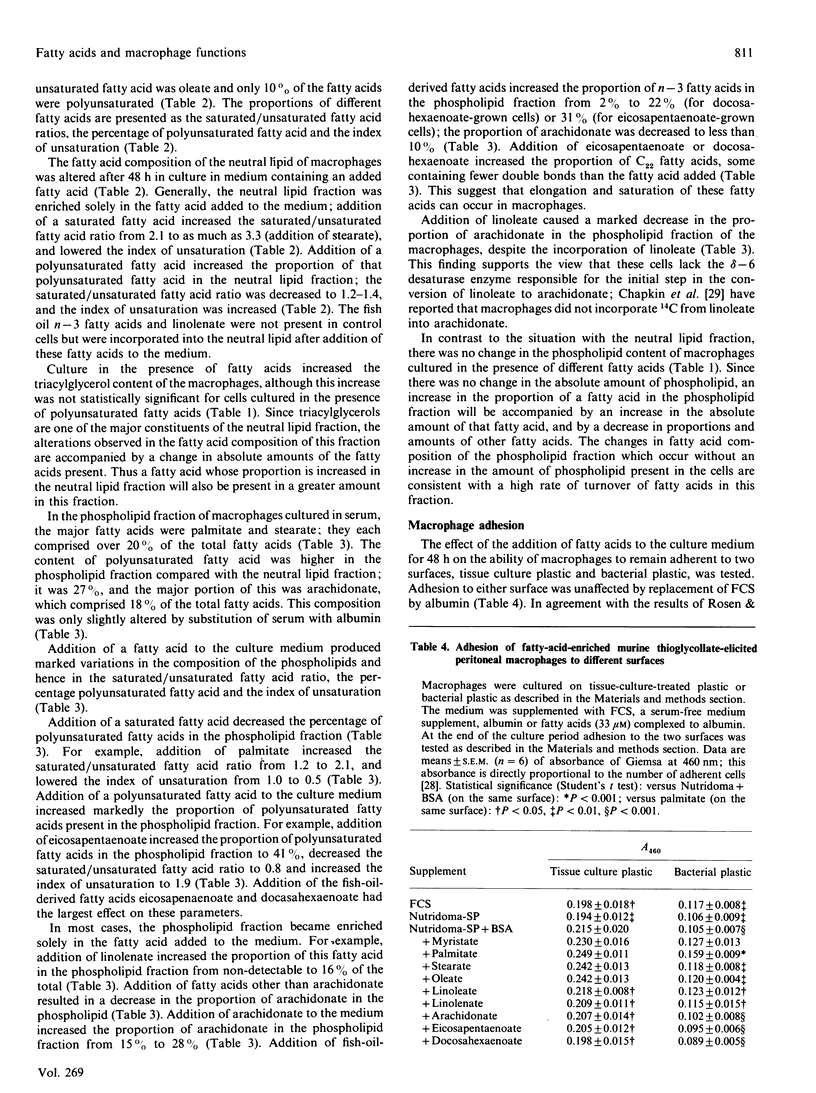
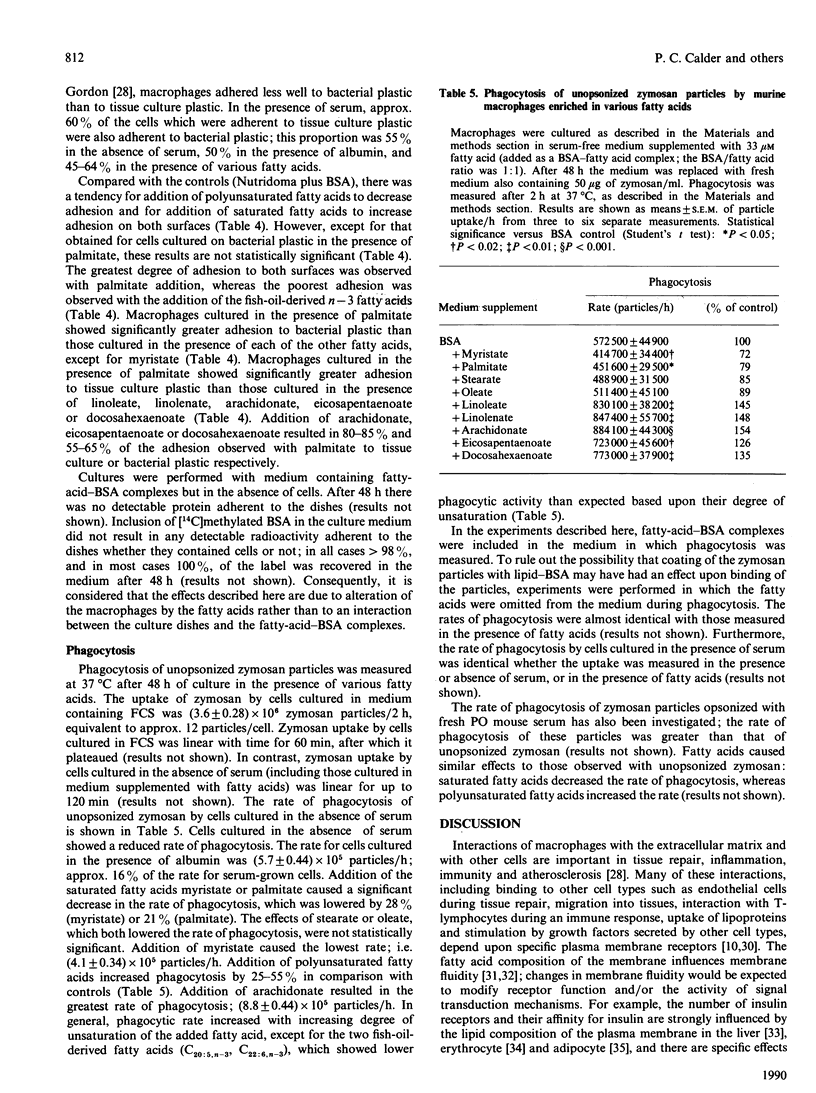
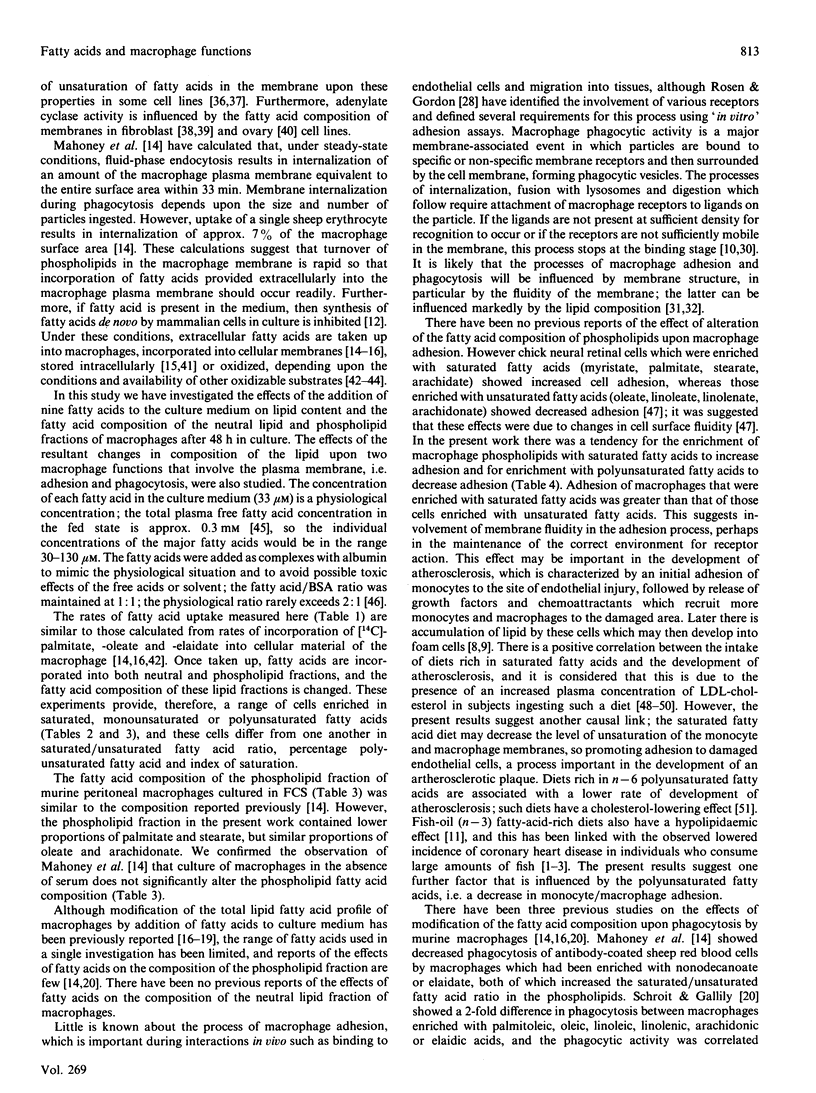
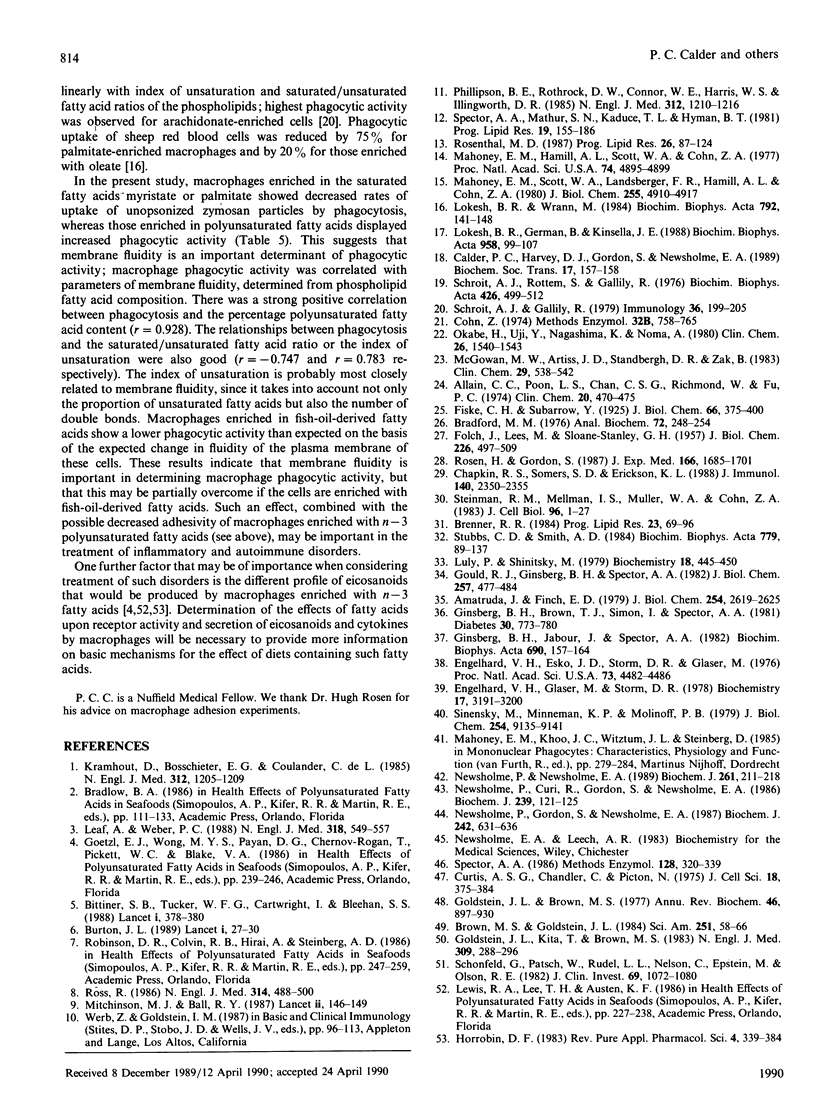
Selected References
These references are in PubMed. This may not be the complete list of references from this article.
- Allain C. C., Poon L. S., Chan C. S., Richmond W., Fu P. C. Enzymatic determination of total serum cholesterol. Clin Chem. 1974 Apr;20(4):470–475. [PubMed] [Google Scholar]
- Amatruda J. M., Finch E. D. Modulation of hexose uptake and insulin action by cell membrane fluidity. The effects of temperature on membrane fluidity, insulin action, and insulin binding. J Biol Chem. 1979 Apr 25;254(8):2619–2625. [PubMed] [Google Scholar]
- Bittiner S. B., Tucker W. F., Cartwright I., Bleehen S. S. A double-blind, randomised, placebo-controlled trial of fish oil in psoriasis. Lancet. 1988 Feb 20;1(8582):378–380. doi: 10.1016/s0140-6736(88)91181-6. [DOI] [PubMed] [Google Scholar]
- Bradford M. M. A rapid and sensitive method for the quantitation of microgram quantities of protein utilizing the principle of protein-dye binding. Anal Biochem. 1976 May 7;72:248–254. doi: 10.1006/abio.1976.9999. [DOI] [PubMed] [Google Scholar]
- Brenner R. R. Effect of unsaturated acids on membrane structure and enzyme kinetics. Prog Lipid Res. 1984;23(2):69–96. doi: 10.1016/0163-7827(84)90008-0. [DOI] [PubMed] [Google Scholar]
- Brown M. S., Goldstein J. L. How LDL receptors influence cholesterol and atherosclerosis. Sci Am. 1984 Nov;251(5):58–66. doi: 10.1038/scientificamerican1184-58. [DOI] [PubMed] [Google Scholar]
- Burton J. L. Dietary fatty acids and inflammatory skin disease. Lancet. 1989 Jan 7;1(8628):27–31. doi: 10.1016/s0140-6736(89)91682-6. [DOI] [PubMed] [Google Scholar]
- Chapkin R. S., Somers S. D., Erickson K. L. Inability of murine peritoneal macrophages to convert linoleic acid into arachidonic acid. Evidence of chain elongation. J Immunol. 1988 Apr 1;140(7):2350–2355. [PubMed] [Google Scholar]
- Cohn Z. A. The isolation and cultivation of mononuclear phagocytes. Methods Enzymol. 1974;32:758–765. doi: 10.1016/0076-6879(74)32079-4. [DOI] [PubMed] [Google Scholar]
- Curtis A. S., Chandler C., Picton N. Cell surface lipids and adhesion. III. The effects on cell adhesion of changes in plasmalemmal lipids. J Cell Sci. 1975 Aug;18(3):375–384. doi: 10.1242/jcs.18.3.375. [DOI] [PubMed] [Google Scholar]
- Engelhard V. H., Esko J. D., Storm D. R., Glaser M. Modification of adenylate cyclase activity in LM cells by manipulation of the membrane phospholipid composition in vivo. Proc Natl Acad Sci U S A. 1976 Dec;73(12):4482–4486. doi: 10.1073/pnas.73.12.4482. [DOI] [PMC free article] [PubMed] [Google Scholar]
- Engelhard V. H., Glaser M., Storm D. R. Effect of membrane phospholipid compositional changes on adenylate cyclase in LM cells. Biochemistry. 1978 Aug 8;17(16):3191–3200. doi: 10.1021/bi00609a004. [DOI] [PubMed] [Google Scholar]
- FOLCH J., LEES M., SLOANE STANLEY G. H. A simple method for the isolation and purification of total lipides from animal tissues. J Biol Chem. 1957 May;226(1):497–509. [PubMed] [Google Scholar]
- Ginsberg B. H., Brown T. J., Simon I., Spector A. A. Effect of the membrane lipid environment on the properties of insulin receptors. Diabetes. 1981 Sep;30(9):773–780. doi: 10.2337/diab.30.9.773. [DOI] [PubMed] [Google Scholar]
- Ginsberg B. H., Jabour J., Spector A. A. Effect of alterations in membrane lipid unsaturation on the properties of the insulin receptor of Ehrlich ascites cells. Biochim Biophys Acta. 1982 Sep 9;690(2):157–164. doi: 10.1016/0005-2736(82)90318-2. [DOI] [PubMed] [Google Scholar]
- Goldstein J. L., Brown M. S. The low-density lipoprotein pathway and its relation to atherosclerosis. Annu Rev Biochem. 1977;46:897–930. doi: 10.1146/annurev.bi.46.070177.004341. [DOI] [PubMed] [Google Scholar]
- Goldstein J. L., Kita T., Brown M. S. Defective lipoprotein receptors and atherosclerosis. Lessons from an animal counterpart of familial hypercholesterolemia. N Engl J Med. 1983 Aug 4;309(5):288–296. doi: 10.1056/NEJM198308043090507. [DOI] [PubMed] [Google Scholar]
- Gould R. J., Ginsberg B. H., Spector A. A. Lipid effects on the binding properties of a reconstituted insulin receptor. J Biol Chem. 1982 Jan 10;257(1):477–484. [PubMed] [Google Scholar]
- Horrobin D. F. The regulation of prostaglandin biosynthesis by the manipulation of essential fatty acid metabolism. Rev Pure Appl Pharmacol Sci. 1983 Oct-Dec;4(4):339–383. [PubMed] [Google Scholar]
- Kromhout D., Bosschieter E. B., de Lezenne Coulander C. The inverse relation between fish consumption and 20-year mortality from coronary heart disease. N Engl J Med. 1985 May 9;312(19):1205–1209. doi: 10.1056/NEJM198505093121901. [DOI] [PubMed] [Google Scholar]
- Leaf A., Weber P. C. Cardiovascular effects of n-3 fatty acids. N Engl J Med. 1988 Mar 3;318(9):549–557. doi: 10.1056/NEJM198803033180905. [DOI] [PubMed] [Google Scholar]
- Lokesh B. R., German B., Kinsella J. E. Differential effects of docosahexaenoic acid and eicosapentaenoic acid on suppression of lipoxygenase pathway in peritoneal macrophages. Biochim Biophys Acta. 1988 Jan 19;958(1):99–107. doi: 10.1016/0005-2760(88)90250-0. [DOI] [PubMed] [Google Scholar]
- Lokesh B. R., Wrann M. Incorporation of palmitic acid or oleic acid into macrophage membrane lipids exerts differential effects on the function of normal mouse peritoneal macrophages. Biochim Biophys Acta. 1984 Feb 9;792(2):141–148. doi: 10.1016/0005-2760(84)90215-7. [DOI] [PubMed] [Google Scholar]
- Luly P., Shinitzky M. Gross structural changes in isolated liver cell plasma membranes upon binding of insulin. Biochemistry. 1979 Feb 6;18(3):445–450. doi: 10.1021/bi00570a009. [DOI] [PubMed] [Google Scholar]
- Mahoney E. M., Hamill A. L., Scott W. A., Cohn Z. A. Response of endocytosis to altered fatty acyl composition of macrophage phospholipids. Proc Natl Acad Sci U S A. 1977 Nov;74(11):4895–4899. doi: 10.1073/pnas.74.11.4895. [DOI] [PMC free article] [PubMed] [Google Scholar]
- Mahoney E. M., Scott W. A., Landsberger F. R., Hamill A. L., Cohn Z. A. Influence of fatty acyl substitution on the composition and function of macrophage membranes. J Biol Chem. 1980 May 25;255(10):4910–4917. [PubMed] [Google Scholar]
- McGowan M. W., Artiss J. D., Strandbergh D. R., Zak B. A peroxidase-coupled method for the colorimetric determination of serum triglycerides. Clin Chem. 1983 Mar;29(3):538–542. [PubMed] [Google Scholar]
- Mitchinson M. J., Ball R. Y. Macrophages and atherogenesis. Lancet. 1987 Jul 18;2(8551):146–148. doi: 10.1016/s0140-6736(87)92341-5. [DOI] [PubMed] [Google Scholar]
- Newsholme P., Curi R., Gordon S., Newsholme E. A. Metabolism of glucose, glutamine, long-chain fatty acids and ketone bodies by murine macrophages. Biochem J. 1986 Oct 1;239(1):121–125. doi: 10.1042/bj2390121. [DOI] [PMC free article] [PubMed] [Google Scholar]
- Newsholme P., Gordon S., Newsholme E. A. Rates of utilization and fates of glucose, glutamine, pyruvate, fatty acids and ketone bodies by mouse macrophages. Biochem J. 1987 Mar 15;242(3):631–636. doi: 10.1042/bj2420631. [DOI] [PMC free article] [PubMed] [Google Scholar]
- Newsholme P., Newsholme E. A. Rates of utilization of glucose, glutamine and oleate and formation of end-products by mouse peritoneal macrophages in culture. Biochem J. 1989 Jul 1;261(1):211–218. doi: 10.1042/bj2610211. [DOI] [PMC free article] [PubMed] [Google Scholar]
- Okabe H., Uji Y., Nagashima K., Noma A. Enzymic determination of free fatty acids in serum. Clin Chem. 1980 Oct;26(11):1540–1543. [PubMed] [Google Scholar]
- Phillipson B. E., Rothrock D. W., Connor W. E., Harris W. S., Illingworth D. R. Reduction of plasma lipids, lipoproteins, and apoproteins by dietary fish oils in patients with hypertriglyceridemia. N Engl J Med. 1985 May 9;312(19):1210–1216. doi: 10.1056/NEJM198505093121902. [DOI] [PubMed] [Google Scholar]
- Rosen H., Gordon S. Monoclonal antibody to the murine type 3 complement receptor inhibits adhesion of myelomonocytic cells in vitro and inflammatory cell recruitment in vivo. J Exp Med. 1987 Dec 1;166(6):1685–1701. doi: 10.1084/jem.166.6.1685. [DOI] [PMC free article] [PubMed] [Google Scholar]
- Rosenthal M. D. Fatty acid metabolism of isolated mammalian cells. Prog Lipid Res. 1987;26(2):87–124. doi: 10.1016/0163-7827(87)90009-9. [DOI] [PubMed] [Google Scholar]
- Ross R. The pathogenesis of atherosclerosis--an update. N Engl J Med. 1986 Feb 20;314(8):488–500. doi: 10.1056/NEJM198602203140806. [DOI] [PubMed] [Google Scholar]
- Schonfeld G., Patsch W., Rudel L. L., Nelson C., Epstein M., Olson R. E. Effects of dietary cholesterol and fatty acids on plasma lipoproteins. J Clin Invest. 1982 May;69(5):1072–1080. doi: 10.1172/JCI110542. [DOI] [PMC free article] [PubMed] [Google Scholar]
- Schroit A. J., Gallily R. Macrophage fatty acid composition and phagocytosis: effect of unsaturation on cellular phagocytic activity. Immunology. 1979 Feb;36(2):199–205. [PMC free article] [PubMed] [Google Scholar]
- Schroit A. J., Rottem S., Gallily R. Motion of spin-labeled fatty acids in murine macrophages. Relation to cellular phagocytic activity. Biochim Biophys Acta. 1976 Mar 19;426(3):499–512. doi: 10.1016/0005-2736(76)90394-1. [DOI] [PubMed] [Google Scholar]
- Sinensky M., Minneman K. P., Molinoff P. B. Increased membrane acyl chain ordering activates adenylate cyclase. J Biol Chem. 1979 Sep 25;254(18):9135–9141. [PubMed] [Google Scholar]
- Spector A. A., Mathur S. N., Kaduce T. L., Hyman B. T. Lipid nutrition and metabolism of cultured mammalian cells. Prog Lipid Res. 1980;19(3-4):155–186. doi: 10.1016/0163-7827(80)90003-x. [DOI] [PubMed] [Google Scholar]
- Spector A. A. Structure and lipid binding properties of serum albumin. Methods Enzymol. 1986;128:320–339. doi: 10.1016/0076-6879(86)28077-5. [DOI] [PubMed] [Google Scholar]
- Steinman R. M., Mellman I. S., Muller W. A., Cohn Z. A. Endocytosis and the recycling of plasma membrane. J Cell Biol. 1983 Jan;96(1):1–27. doi: 10.1083/jcb.96.1.1. [DOI] [PMC free article] [PubMed] [Google Scholar]
- Stubbs C. D., Smith A. D. The modification of mammalian membrane polyunsaturated fatty acid composition in relation to membrane fluidity and function. Biochim Biophys Acta. 1984 Jan 27;779(1):89–137. doi: 10.1016/0304-4157(84)90005-4. [DOI] [PubMed] [Google Scholar]


